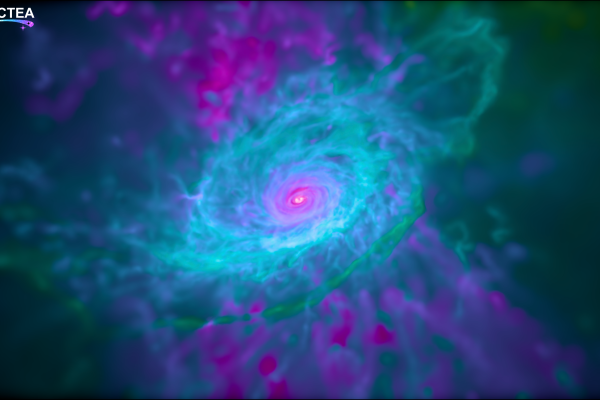The Virgo, LIGO and KAGRA scientific collaborations today announced the first observation ever of binary systems consisting of a black hole and a neutron star (NSBH). This was made possible by the detection, in January 2020, of gravitational signals emitted by two systems, in which a black hole and a neutron star, rotating around each other, merged into a single compact object. The existence of these systems was predicted by astronomers several decades ago, but they had never been observed with confidence, either through electromagnetic or gravitational signals, until now. The result and its astrophysical implications have been published today in The Astrophysical Journal Letters.
Six spanish groups have contributed to the study and analysis of the gravitational waves detected by LIGO-Virgo, in areas that range from the theoretical models of the astorphysical sources and data analysis to the improvement of the sensitivity of the detectors for present and future observation periods. Two groups, in the University of the Balearic Islands (UIB) and the Instituto Galego de Física de Altas Enerxías (IGFAE) of the University of Santiago de Compostela (USC), are part of the LIGO Scientific Collaboration while the University of Valencia, the Institute of Cosmos Sciences of the University of Barcelona (ICCUB), the The Institute for High Energy Physics of Barcelona (IFAE) and the Institute for Theoretical Physics of the Autonomous University of Madrid-CSIC are members of Virgo.
On the 5th of January, 2020, the Advanced LIGO detector in Livingston, Louisiana in the US, and the Advanced Virgo detector in Italy, observed a gravitational wave produced by the last few decaying orbits, before the merging, of a NSBH pair; just ten days later a second gravitational-wave signal from the inspiral and merger of a similar binary system, was observed, this time by both Advanced LIGO detectors and the Virgo detector. These two events, nicknamed GW200105 and GW200115 (from the dates of their detection), represent the first observations of gravitational waves generated by a mix of neutron stars and black holes. Two past gravitational signals (GW190814 and GW190426) have been considered NSBH candidates, but without a sufficient level of confidence.
“Double neutron star systems were first observed in the Milky Way in 1974 by monitoring pulses of radio waves emitted by the neutron stars, known as radio pulsars. “Astronomers have spent decades searching for radio pulsars orbiting black holes, but have found none in the Milky Way up to now,” says Astrid Lamberts, CNRS researcher of the Virgo collaboration at Artemis and Lagrange laboratories, in Nice “ Black hole and neutron star pairs were indeed for astronomers the ‘missing binary’. With this new discovery, we can finally begin to understand how many of these systems exist, how often they merge, and why we have not yet seen examples in the Milky Way.”
The gravitational signals detected in January encode valuable information about the physical features of the systems, such as the mass and distance of the two NSBH pairs, as well as about the physical mechanisms that have generated them and bring them to collapse. The signal analysis has shown that the black hole and neutron star that created GW200105 are, respectively, about 8.9 times and 1.9 times the mass of our Sun (Mo) and their merger happened around 900 million years ago, hundreds of millions of years before the first dinosaurs appeared on Earth. For the GW200115 event, the Virgo and LIGO scientists estimate the two compact objects had masses around 5.7 Mo (BH) and 1.5 Mo (NS) and that they merged almost 1 billion years ago.
The estimated heavier mass in both cases fits within the range predicted for black holes by stellar evolution models. The lighter mass is also consistent with neutron stars and these results indicate that both detected systems are NSBH pairs, even if they have different confidence levels. In this regard, although the statistical significance of GW200105 is not very high, the ‘shape’ of the signal as well as the parameters inferred from the analyses, lead the researchers to believe in its astrophysical origin.
“A large amount of work and computational resources has been dedicated to this parameter estimation. Indeed a crucial issue in the analysis of the data recorded by gravitational-wave detectors is to disentangle the useful information, which always comes mixed with the noise”, said Giancarlo Cella, INFN researcher and Virgo data analysis coordinator. “We need to obtain our best estimates for the properties of the sources and at the same time we want to know what is the probability that the identified signal might be just a random fluctuation”
An additional proof of the detection of a mixed neutron star black-hole system would have been the detection of electromagnetic radiation along with the gravitational waves. In fact, if the masses of the two compact objects are roughly comparable, the neutron star, while approaching the black hole, is subjected to such powerful tidal forces that it is broken up. In this case, in addition to gravitational emissions, one could also observe spectacular flares of electromagnetic radiation, due to the disintegration of the stellar matter around the black hole: a mechanism similar to that which leads to the formation of accretion disks around giant black holes at the center of galaxies. This probably did not occur for either GW200105 or GW200115, because in both cases the mass of the black hole was too large, so once the separation between the two objects has been sufficiently reduced, the black hole has, so to speak, swallowed its companion in one bite.
“We got the evidence that our sensitivity is now above the threshold needed for detecting systems of this kind”, claimed Cella, “and we expect that we will do this routinely in the next runs.”
Drawing a new cosmic landscape
“The fact that we have now detected the three types of binaries will help us to develop theories that explain the properties of all of them consistently”, added Astrid Lamberts “In fact, this discovery allows us to deepen our knowledge of the most extreme phenomena in the Universe, helping us understand better which mechanisms may have generated them.”
The result announced today, alongside the dozens of detections made by Virgo and LIGO to date, allow us, for the first time, a close observation of some of the most violent and rare phenomena in the Universe and to draw an unprecedented picture of the crowded and chaotic regions that are one of the possible nursery environments of these events. Furthermore, the detailed information we have started to collect about the physics of the black hole and star mergers, gives us the chance to test the fundamental laws of physics at extreme conditions, which obviously we will never be able to reproduce on Earth.
“The discovery announced today is one more gem in the treasure of the 3rd LIGO-Virgo observing run”, stated Giovanni Losurdo, Virgo spokesperson and INFN researcher. “LIGO and Virgo keep unveiling catastrophic collisions, which have never been observed before, shedding light on a truly new cosmic landscape. We are now upgrading the detectors with the aim of looking much farther into the depth of the cosmos, searching for new gems, seeking a deeper understanding of the universe we live in.”
IN DEPTH CONTENTS
How does a black hole and neutron star pair form and merge? (see Infographics)
The current astrophysical models roughly consider two main theoretical scenarios for the formation of NSBH pairs. One, called “isolated binary evolution”, starts with two stars orbiting around one another, which, at the end of their life, become, after supernova explosions, a still-bound-together black hole and neutron star. The other possibility is that the neutron star and black hole form from separate stars in unrelated supernova explosions, and only afterwards find one another. This, called “dynamical interaction”, can be triggered by different physical mechanisms in dense stellar environments, such as globular clusters, young clusters or even the accretion disks of active galactic nuclei.
Based on these different theoretical scenarios it is possible to make predictions, for example, about the orientations of the black hole and neutron star rotations with respect to the orbital motions (i.e. their so called “spins”) or, more generally, about how many NSBH pairs merge in the Universe within a given time period (a quantity called the “merger rate”). Thanks to the detections announced today, for the first time, these predictions can be compared with the data of the two observed NSBH pairs, and we can start discriminating between the different astrophysical models.
For instance, considering that only these two NSBH events have been detected during all of the LIGO and VIRGO observing runs, it turns out that between 5 and 15 such systems merge per year within a distance of one billion light years from Earth. This rate appears to be especially consistent with both the isolated binary evolution and the dynamical interaction in young star clusters or in active galactic nuclei; however this estimated rate, as well as the measured spin values of GW200105 and GW200115, do not allow to single out just one specific formation scenario.
Multimedia materials:
https://bit.ly/3ja75hB
Gravitational-wave observatories:
The Virgo Collaboration is currently composed of approximately 700 members from 126 institutions in 15 different (mainly European) countries. The European Gravitational Observatory (EGO) hosts the Virgo detector near Pisa in Italy, and is funded by Centre National de la Recherche Scientifique (CNRS) in France, the Istituto Nazionale di Fisica Nucleare (INFN) in Italy, and Nikhef in the Netherlands. A list of the Virgo Collaboration groups can be found at http://public.virgo-gw.eu/the-virgo-collaboration/. More information is available on the Virgo website at http://www.virgo-gw.eu
LIGO is funded by the National Science Foundation (NSF) and operated by Caltech and MIT, which conceived of LIGO and led the project. Financial support for the Advanced LIGO project was led by the NSF, with Germany (Max Planck Society), the U.K. (Science and Technology Facilities Council) and Australia (Australian Research Council-OzGrav) making significant commitments and contributions to the project. Approximately 1,300 scientists from around the world participate in the effort through the LIGO Scientific Collaboration, which includes the GEO Collaboration. A list of additional partners is available at https://my.ligo.org/census.php.
The KAGRA laser interferometer, with 3-kilometer-long arms, is located in Kamioka, Gifu, Japan. The host institute is the Institute of Cosmic Ray Researches (ICRR) at the University of Tokyo, and the project is co-hosted by National Astronomical Observatory in Japan (NAOJ) and High Energy Accelerator Research Organization (KEK). KAGRA completed its construction in 2019, and later joined the international gravitational-wave network of LIGO and Virgo. The actual data taking was started in February 2020 during the final stage of the run called "O3b." KAGRA Scientific Congress is composed of over 470 members from 115 institutes in 14 countries/regions. The list of researchers is available from http://gwwiki.icrr.u-tokyo.ac.jp/JGWwiki/KAGRA/KSC/Researchers. KAGRA information is at the website https://gwcenter.icrr.u-tokyo.ac.jp/en/.



